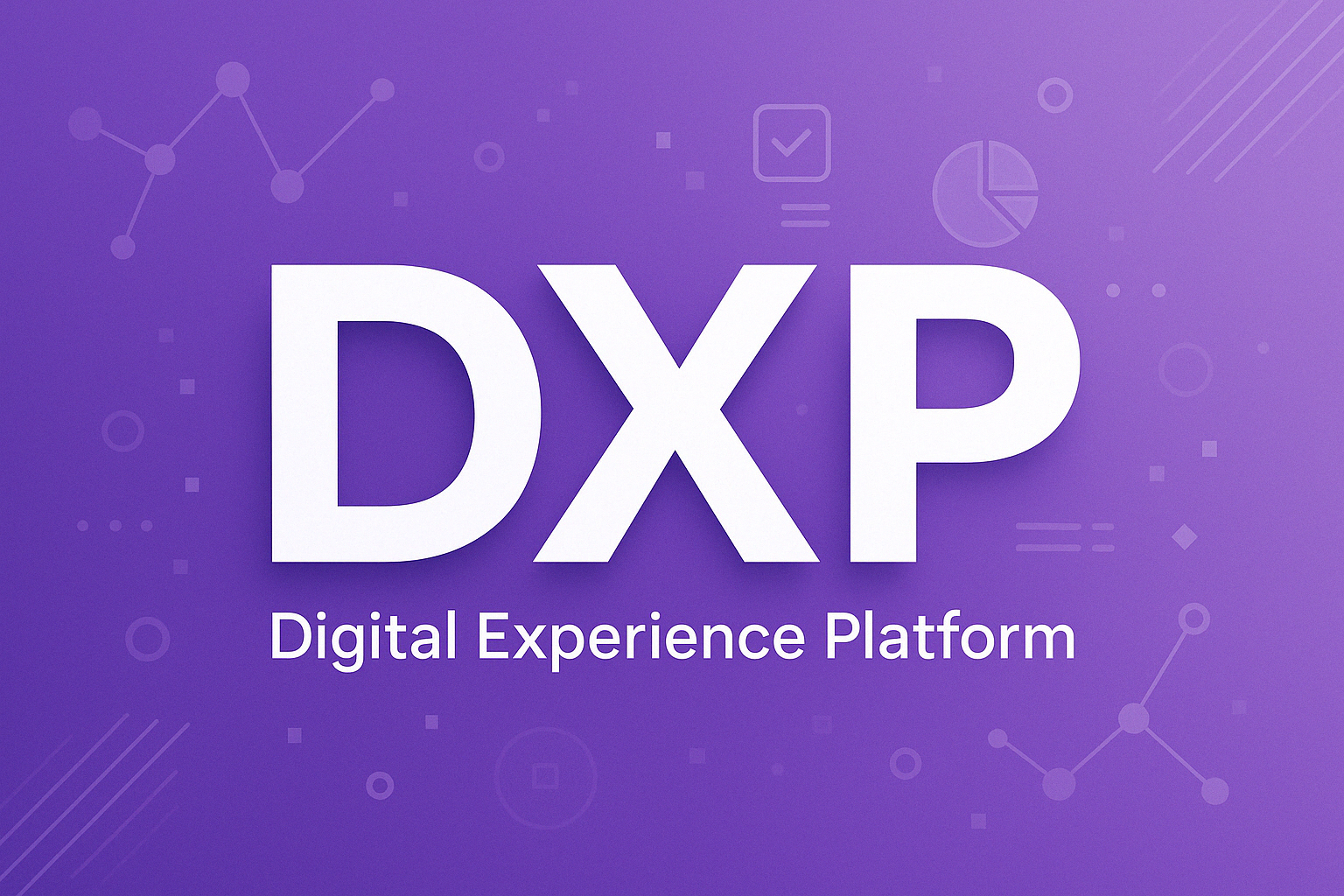What is a DXP and why does your company need it?
The Basis for Intelligent Digital Experiences
A DXP (Digital Experience Platform) is a platform that centralizes tools for creating, managing, personalizing, and optimizing digital experiences across different channels — such as websites, apps, portals, social media, and voice assistants. More than just technology, it is a strategy that puts the customer at the center of every digital interaction.
In practice, it helps organizations stay competitive by facilitating relationship building through communication – using content to express and data to listen.
The DXP is part of a digital business ecosystem, integrating various applications, services, and data sources with cloud capabilities, for deployment as Saas or PaaS, providing versatility, scalability, elasticity, cost efficiency, and improved time-to-market.
Customer data management for deep user behavior understanding provides insights for creating segments based on attributes from various distinct sources. Continuously evaluating and improving the performance, effectiveness, and usefulness of digital experiences.
According to Gartner's study, by 2026, at least 70% of organizations will be required to adopt DXP technology – which allows greater flexibility, agility, and innovation. This trend reflects a strategic transformation in how companies digitally relate to their customers and partners, needing to adapt to the pace of changes in consumer behavior and emerging technologies such as AI, advanced personalization, and omnichannel experiences.
The Evolution of Digital Experience Platforms
In today's complex world, where there is a need to bring distinct and personalized content to each type of user and client, the urgency is to connect experiences across multiple channels: websites, applications, customer portals, signage, social media, IoT devices, and much more.
Today, in Brazil, people spend on average 5 hours a day immersed in their phones, according to Data.AI research. This makes it even clearer that it's not enough to deliver content in each channel; they must come together in a consistent, connected, and continuous experience that guides each person to a clear goal, especially when Google indicates the four key behaviors that influence the new consumer journey: searching, scrolling, streaming, and shopping – research, screen scrolling, continuous and personalized content consumption, and the act of purchasing.
In practice, no one wants to receive an email announcing a product they just purchased. Or click on a link offering a discount for sneakers only to be taken to a page with socks. Digital experience platforms have evolved to tackle these challenges.
CMS for WEM and, Subsequently, DXP.
The first CMS (Content Management Systems) emerged in the late 80s and early 90s, enabling static content similar to brochures. By the late 90s, dynamic content appeared with the rise of the social web.
With this growth, user-generated content and mobility, the need for more personalized engagements arose, leading to WEM (Web Experience Management) and consequently, companies began collecting engagement data, building personas, and using this data to create personalized experiences. However, the product was created with only marketing in mind, making it hard to connect it with other corporate systems, such as CRM or ERP.
Imagine an online retailer investing in campaigns to attract customers, but after capturing interest on their site, failing to pass this information to the sales or service team, resulting in lost opportunities and disconnected consumer experiences.
With the evolution of digital needs and the multiplication of channels, more flexible architectures emerged, allowing the integration of various systems to offer fluid and connected experiences. This change also strengthened a customer-centric approach, with a focus on omnichannel journeys.
The combination of these capabilities led to the emergence of DXPs, enabling integrated management of the customer experience across any channel or device, from first contact to conversion and beyond.

Digital Experience Platforms and Digital Transformation
DXPs are more than just a set of technological tools; they are key elements in companies' digital transformation. They allow an organization to communicate in an integrated manner with its audiences, ensuring the customer experience is consistent across all channels.
But it is not enough just to adopt a DXP. The company must change the way it works: break down barriers between areas, form collaborative teams, adopt agile practices, and create continuous improvement routines based on customer behavior and real data. In other words, the DXP is the technological arm, but the change must originate from a change in culture and internal organization.
Furthermore, modern DXPs help companies ensure security, regulatory compliance, and adherence to LGPD, centralizing data and offering control over how users' information is collected, stored, and used. This enables customer experience evolution with responsibility and transparency.
When Does Your Company Need a DXP?
Every company that cares about user experience needs it, but if you identify with some of the points below, the time may be now:
- Customer experience needs to be integrated across multiple channels: web, mobile, email, social media, etc.
- The roadmap includes adopting new technologies, systems, and data to optimize UX and conversion.
- The team wants to personalize experiences based on real data and deliver segmented content in real-time.
- You need a platform that combines management, personalization, and analysis, with governance and scalability.
- It's time to evolve from an institutional digital presence to a strategy centered on the customer's digital journey.
Pains a DXP Solves
For Marketing:
- Lack of autonomy to edit websites and campaigns.
- Difficulty in personalizing content at scale.
- Low visibility of channel performance.
- Delays in campaign launches due to reliance on IT.
For IT:
- Fragmented management of multiple digital solutions.
- High operational demand from business areas.
- Lack of integration between systems and channels.
- Challenges in ensuring performance, security, and scalability.
Benefits of a DXP
- Personalization at scale: experiences adapted to each user's profile and behavior.
- Centralized and omnichannel management: a single base for multiple channels.
- Agility with low-code: quick updates with less technical effort.
- Data and systems integration: unified view of the customer.
- Continuous insights and optimization with AI: make data-driven decisions in real-time.
- Scalability and governance: version control, permissions, and approval flow.
- Flexible and future-ready platform: open for integrations and continuous innovation.
The Role of AI in Modern DXPs
Artificial intelligence is the heart of a modern DXP. It analyzes data from different channels, identifies patterns, creates segments, and automates the delivery of personalized content. Additionally, it allows for:
- Smart A/B testing
- Content recommendation
- Real-time journey optimization
- Sentiment analysis
- Automation of workflows based on behavior
How to Choose the Ideal DXP?
- Map your needs: avoid being dazzled by features. Prioritize what truly adds value to your business.
- Evaluate your digital maturity: is the company ready for this transformation?
- Consult experts: analysts like Gartner and Forrester can help you understand the supplier landscape.
- Study cases from your sector: see what similar companies have done and what worked.
- Plan a progressive adoption: think of a digital evolution roadmap with clear and measurable steps.
How LumisXP Stands Out as a DXP
LumisXP is a Brazilian DXP developed to deliver agility, intelligence, and security to companies looking to accelerate their digital transformation. We are pioneers in Brazil with over 23 years of experience, offering:
- 100% customizable and scalable platform
- AI applied to digital experience
- Robust corporate governance
- Integration with CRM, marketing automation, and more
- Local support and consultative service
The Future of Digital Experiences
Content is the foundation of any digital experience, whether on a website, app, email, advertisement, or any other type of communication. It is through content that brands impact and connect with people. Therefore, investing in a DXP is essential for companies that want to grow and stand out in the digital environment.
In a constantly changing world, the right DXP needs to be able to evolve with your business, connecting teams, channels, and technologies fluidly to ensure increasingly relevant experiences for your audiences.

